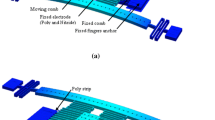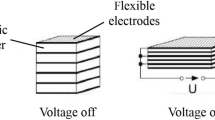Abstract
A novel vertical actuator based on electrowetting on dielectric (EWOD) was designed, analyzed and simulated. Modeling results indicated that the vertical driving force of the actuator obeyed a second order polynomial of applied voltage, which was verified by Covent_ware 2006. As a result, the vertical driving force of the EWOD actuator with a 1.1nL droplet and a 1.75 μm thick polymer was about 0.5 μN under an applied voltage 100V which was comparable to that of the electrostatic actuators. Moreover, the noise from plane forces we analyzed and simulated was very low. Therefore, we made a conclusion that the EWOD actuator can be used in MEMS transducer.
Similar content being viewed by others
References
Verheijen H.J.J., Prins M.W.J.: Contact angle and wetting velocity measured electrically. Rev. Sci. Instrum. 70, 3668–3673 (1999)
Feenstral, B.J., Hayes, R.A., Dijk, R.V.: Electrowetting-based displays: bringing microfluidics alive on-screen. In: Proc. MEMS2006, 22–26 January 2006, pp. 48–53. Istanbul, Turkey (2006)
Hoshino, K. et al.: Electrowetting-based actuation for microinjection. In: TRANSDUCERS Solid-State Sensors, Actuators and Microsystems, 12th International Conference on, 2003, vol. 2(8–12), pp. 1800–1803. IEEE, Boston (2003)
Kwang, S.Y., Cho, J., Bu, J.U., Kim, G.H., Jeon, Y.S., Kim, C.J., Euisik Yoon: A micropump driven by continuous electrowetting actuation for low voltage and low power operations. In: Proc. IEEE MEMS Workshop, pp. 487–490 (2001)
Junghoon L., Kim C.J.: Surface-tension-driven microactuation based on continuous electrowetting, J. MEMS 9(2), 171–180 (2000)
Cho S.K., Hyejin M., Kim C.J.: Creating, transporting, cutting, and merging liquid droplets by electrowetting-based actuation for digital microfluidic circuits. J. MEMS 12(1), 70–80 (2003)
Jan L., Andreas G., Jan G.K.: Modeling, simulation, and optimization of electrowetting. Trans. IEEE CAD IC SYS 25(2), 234–247 (2006)
Hyungmin, K., Joonwon, K.: EWOD (Electrowetting-on-dielectric) actuated optical micromirror. In: Proc. MEMS2006, 22–26 January 2006, pp. 742–745. Istanbul, Turkey (2006)
Takei, A., Iwase, E., Hoshino, K.: Angle tunable liquid wedge prism driven by electrowetting. In: Proc. MEMS2006, 22–26 January 2006, pp. 36–39. Istanbul, Turkey (2006)
Zeng X.F., Yue R.F., Wu J.G.: Actuation and control of droplets by using electrowetting-on-dielectric. CPL 21(9), 1851–1854 (2004)
Dai W., Zhao Y.P.: The nonlinear phenomena of thin polydimethylsiloxane (PDMS) films in electrowetting. Int. J. Nonlinear Sci. 8(4), 519–526 (2007)
Dai W., Zhao Y.P.: An electrowetting model for rough surfaces under low voltage. J. Adhes. Sci. Technol. 22(2), 217–229 (2008)
Clarence, A.M., Neogi, P. Marcel, D.: Interfacial Phenomena: Equilibrium and Dynamic Effects, pp. 49–75. CRC Press, Boca Raton (1985)
Author information
Authors and Affiliations
Corresponding author
Rights and permissions
About this article
Cite this article
An, P., Chen, J. & Hao, Y. Modeling and simulation of a novel vertical actuator based on electrowetting on dielectric. Acta Mech Sin 25, 669–675 (2009). https://doi.org/10.1007/s10409-009-0263-5
Received:
Revised:
Accepted:
Published:
Issue Date:
DOI: https://doi.org/10.1007/s10409-009-0263-5




